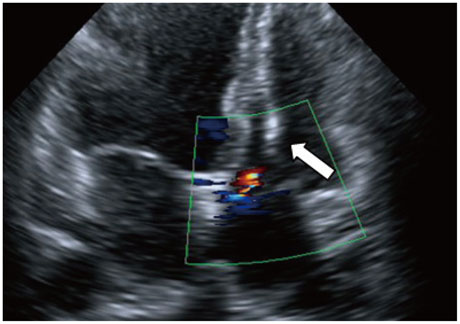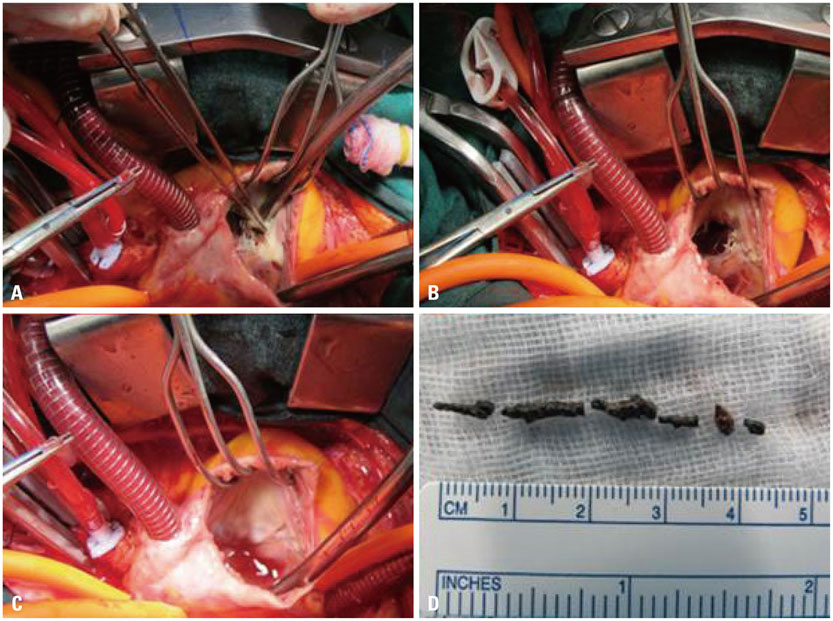Yonsei Med J.
2015 May;56(3):867-870. 10.3349/ymj.2015.56.3.867.
Metallic Foreign Body in Heart Mimicking Moderator Band
- Affiliations
-
- 1Division of Cardiology, Yonsei Cardiovascular Center, Yonsei University College of Medicine, Seoul, Korea. cdhlyj@yuhs.ac
- 2Department of Thoracic and Cardiovascular Surgery, Yonsei Cardiovascular Center, Yonsei University College of Medicine, Seoul, Korea.
- KMID: 2450366
- DOI: http://doi.org/10.3349/ymj.2015.56.3.867
Abstract
- A foreign body in heart is rare, but it is more frequently encountered than the past as iatrogenic causes are increasing. Clinicians should be aware that foreign body could be mistaken for normal structure of heart. In order for accurate diagnosis, multi-imaging modalities should be used for information of exact location, mobility and hemodynamic effects. A decision to intervene should be made based on potential harms harbored by foreign bodies. Endovascular retrieval should be considered as an option. However, when fatal complications occur or when foreign bodies are embedded deeply, a surgical removal should be attempted.
Keyword
MeSH Terms
Figure
Reference
-
1. Wang X, Zhao X, Du D, Xiang X. Management of metallic foreign bodies in the heart. J Card Surg. 2012; 27:704–706.
Article2. Mamede RC, Amaral Fd, Raimundo DG, Freitas LC, Ricz HM, Mello Filho FV. Do foreign bodies migrate through the body towards the heart? Braz J Otorhinolaryngol. 2009; 75:195–199.
Article3. Schechter DC, Gilbert L. Injuries of the heart and great vessels due to pins and needles. Thorax. 1969; 24:246–253.
Article4. Symbas PN, Picone AL, Hatcher CR, Vlasis-Hale SE. Cardiac missiles. A review of the literature and personal experience. Ann Surg. 1990; 211:639–647.5. Jamilla FP, Casey LC. Self-inflicted intramyocardial injury with a sewing needle: a rare cause of pneumothorax. Chest. 1998; 113:531–534.
Article6. Mandegar MH, Ali Yousefnia M, Rayatzadeh H, Roshanali F. Intramyocardial sewing needle extracted one year after insertion. Interact Cardiovasc Thorac Surg. 2006; 5:742–743.
Article7. Actis Dato GM, Arslanian A, Di Marzio P, Filosso PL, Ruffini E. Posttraumatic and iatrogenic foreign bodies in the heart: report of fourteen cases and review of the literature. J Thorac Cardiovasc Surg. 2003; 126:408–414.
Article8. Lundy JB, Johnson EK, Seery JM, Pham T, Frizzi JD, Chasen AB. Conservative management of retained cardiac missiles: case report and literature review. J Surg Educ. 2009; 66:228–235.
Article9. Low GS, Jenkins NP, Prendergast BD. Images in cardiology. Needle embolism in an intravenous drug user. Heart. 2006; 92:315.10. Kataoka H. Cardiac tamponade caused by penetration of an acupuncture needle into the right ventricle. J Thorac Cardiovasc Surg. 1997; 114:674–676.
Article11. Perrotta S, Perrotta A, Lentini S. In patients with cardiac injuries caused by sewing needles is the surgical approach the recommended treatment? Interact Cardiovasc Thorac Surg. 2010; 10:783–792.
Article12. Baker CJ, Nigro JJ, Daggett CW, Wells WJ. Needle embolism to the heart. Ann Thorac Surg. 2004; 77:1102.
Article13. Carroll MI, Ahanchi SS, Kim JH, Panneton JM. Endovascular foreign body retrieval. J Vasc Surg. 2013; 57:459–463.
Article14. Dagdelen S, Yuce M, Caglar N. Percutaneous removal of two intracardiac and pulmonary truncal catheter fragment by using a snare-loop catheter. Int J Cardiol. 2007; 116:413–415.
Article15. Calvagna GM, Romeo P, Ceresa F, Valsecchi S. Transvenous retrieval of foreign objects lost during cardiac device implantation or revision: a 10-year experience. Pacing Clin Electrophysiol. 2013; 36:892–897.
Article
- Full Text Links
- Actions
-
Cited
- CITED
-
- Close
- Share
- Similar articles
-
- Penetrating Orbitocranial Metallic Foreign Body Injury: A Case Report
- A Case of Intraorbital Foreign Body Removed Using A Magnet Under C-arm Fluoroscopy
- A Case of Massive Hemoptysis & Pneumonia Caused by Metallic Foreign Body
- A Gastric Magnetic Foreign Body Incidentally Detected Several Years after Ingestion
- A Case of Epitheloid Sarcoma on Metal Cutoff Worker




